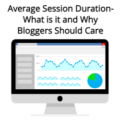When you get into creating and managing a website, at some point you’re going to hear about Google Analytics, especially being told you need to have it on your website. Regardless if you’re a blogger, a small business owner, or a big corporate business, you do need a tool to measure your site’s progress. Google Analytics just happens to be a good one that is also free to use.
So…
What Do You Do After You First Apply Google Analytics to Your Website?

The majority of users may look in on their stats once a day or once a week. Google Analytics provides quite a bit of statistics. You can even set campaigns to analyze traffic from your website and some of your social network handles.
It’s quite alright to take a frequent look at your stats, but if you’re just looking at them and wishing your traffic to improve, then you’re missing out on what Google Analytics can do for you. It takes analyzing what’s going on and planning a campaign to drive attention to those areas of your website that you want people to see.
The great thing about most stats programs, including Google Analytics is that they provide exactly what information you need to know about your visitors. You can even find out if you’re targeting the correct audience, and at what times they hit your website.
Once you’ve installed Google Analytics on your website, you should let it do it’s job in collecting information. After about 3 weeks to a month, you should have a nice tentative spread of your website’s traffic.
When installing Google analytics to your website for the first time, some of the most important stats you should look at are:
- Pageviews
- Percentage of new visitors
- Percentage of returning visitors
- Bounce rate
- How you are acquiring your visitors (where are they coming from)
- Keywords
While there are a TON of other stats, your first time through should be to gather this information and start to put together a first campaign.
Your keywords, acquisition, and your bounce rate with each campaign you plan will change in time depending on how you adjust your website conversion plan.
Keywords
Before you even look at your stats, you really should already have a list of keywords that you’ve been wanting to work on for your website. If your analytics in Google are not coinciding with your intended list, then you’ve got homework to do in creating content around those keywords. Don’t worry, some people have websites for a few years before realizing that they’ve been missing out on capitalizing on being more laser focused on their keyword strategy.
Acquisition
If your website is brand new, you might not have too much information on how you’ve been acquiring your visitors. You will have a small idea, and can use those stats to either focus on those places that are sending you traffic, or working on trying to get traffic from new sources. It might take making sure your website is properly listed on search engines, creating social network handles, and sharing your content.
Bounce Rate
Bounce rate gives you a percentage of how many of your website visitors are only viewing one of your pages, and then leaving. Your bounce rate should never be high. In fact, your strategy should be in converting those visitors to fill out your lead forms, buy your product, share and comment on your blog posts, or even subscribe to your newsletter.
If you can put a plan together that gives you a low bounce rate, great acquisition sources, and above all, making a return on investment, you’re on the right path to great website conversion. The great thing is that Google Analytics is free to use… so what are you waiting for? Go forth and find out how your website is performing!
Do you use Google Analytics in your website conversion strategy? Do you still struggle with deciphering those stats and putting a plan together? If not, what advice do you have for newbies just hooking their website’s up to Google Analytics?


Thank you, Nile! I have a question, how do we work around finding the keywords that display “(not set)” on Google Analytics? Please let me know if you have health with this problem.
You can find (Not set) search words in your Google Analytics account under the tab page Traffic sources > Search > Overview. When you select as a primary dimension: “Search word” Google Analytics will shares all visits that don’t have any information of search words in “Not set”.
A great article! Such a simple yet important topic to focus on. Thanks for sharing Nile!
Currently Google is encouraging us to switch to GA4, which has many functions I didn’t know about. I am trying to use GA4 on my website. Has anyone used GA4 yet?
It’s not that difficult to switch to. I’m using it on my site.